« June 2017 | Main | September 2017 »
July 31, 2017
A future where quality is king -- A look at Zebra's 2017 Manufacturing Vision Study
On July 31st, 2017, Zebra Technologies Corporation published the results of their 2017 Manufacturing Vision Study on emerging trends that are shaping the future of industrial manufacturing. The broad result of the global study suggests that manufacturers are adopting IIoT (Industrial Internet of Things) and Industry 4.0 concepts to get better insights and information about their manufacturing process and, most importantly, to improve quality.
Why Zebra knows
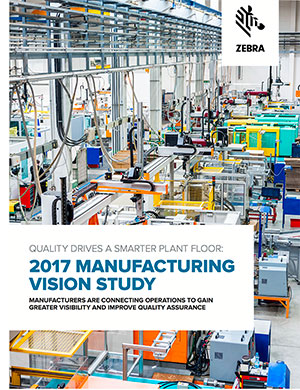
Why should such a study come from Zebra? Isn't Zebra in the mobile printer business? They are, but not only that. Zebra's been around for almost half a century, having started as "Data Specialties Incorporated" back in 1969. They initially made a variety of electromechanical products but soon focused on labeling and ticketing systems. The name changed to Zebra in 1986. A dozen or so strategic acquisitions followed and by 2013 Zebra cracked a billion in sales. And then more than tripled that in one fell swoop by acquiring Motorola Solutions' enterprise business in 2014.
Why do I mention all that? Because Motorola Solutions' enterprise business mostly consisted of the former Symbol Technologies, a pioneer in retail and inventory management bar code scanning systems. In my capacity as Editor-in-Chief of Pen Computing Magazine I visited Symbol's headquarters on Long Island several times before its acquisition by Motorola in 2007. On each visit I was impressed with not only Symbol's scanning and mobile computing technology, but also by the importance they placed on exploring fresh ideas and innovative concepts to push the state-of-the-art in data collection to new levels and in new directions. And by how in tune they were with emerging trends and directions.
Despite Symbol going through rough times in the early 2000s, that innovative spirit never flagged, and that didn't change under Motorola nor under yet another big change when Zebra came along, and it's apparently still there. I don't know how many of the same people are still around, but that spirit of innovation, of dreaming up new concepts and uses, of trying new things, of viewing great hardware as just one part of making business better, that's still there. And it's at the heart of those vision studies that Zebra's been generating.
Vision studies
These vision studies are, truth be told, not super-easy to read and comprehend. On the surface, the studies are surveys of how customers use technology, how they view new developments, and what their plans are for the future.
But Zebra also provides considerable value-added by presenting the survey results with commentary and in the context of emerging trends and directions. That includes not only the obvious, the Internet of Things, but market-specifics, like the Industrial Internet of Things (IIoT), and Industry 4.0 where intelligent networked systems go beyond mere machine control via feedback systems, interdisciplinary cooperation, IoT technology, and advanced resource/demand management to morph into "intelligent" or at least "smart" factories.
Zebra doesn't even stop there. The value-added of the vision studies also includes relating their survey findings to emerging trends, mindsets, and revelations, and how technology can get customers from here to there.
In this latest vision study entitled "Quality Drives a Smarter Plant Floor: 2017 Manufacturing Vision Study," Zebra highlights a major shift and transformation, that from cost-cutting no matter what to quality first.
Exclusive focus on ROI is out. Focus on quality is in
In essence, what's happening is that almost everyone is realizing that cost-cutting in an effort to boost short-term return on investment has been a disaster. That's because while it's certainly a good idea to eliminate waste, far too often cost-cutting has led to loss of quality. The whole concept of quality is extremely multifaceted, but it's almost inevitable that cutting cost just to please investors is quite short-sighted and will almost inevitably lead to lowered quality, and lowered quality will inevitably frustrate and anger customers, no matter how loudly they asked for low prices.
The result of realizing the dangers of exclusive focus on cost cutting to improve ROI is that quality is king again. But wait, don't you inevitably get what you pay for? If manufacturers used to cut costs to remain profitable even as quality suffered, won't a new emphasis on quality increase costs and raise prices?
The price of quality would indeed be higher prices if manufacturers continued business as usual. But Zebra's survey of 1,100 executives from automotive, high tech, food, beverage, tobacco and pharmaceutical companies showed considerable optimism about the positive impact of technology on both quality and revenue. The number of fully-connected smart factories will double in the next five years, the use of emerging technologies will rise, and respondents felt very positive on the impact of technology and automation. And Zebra cites a study by the American Society for Quality (ASQ) that claims that for every dollar spent on a quality monitoring system, companies could expect to see an additional $6 in revenue, a $16 reduction in costs and a $3 increase in profits.
How to improve quality and ROI
But how, exactly, do they expect to get from here to there? From the dead-end of the cutting costs/lowered quality cycle to solid quality and growth?
In essence by using emerging technology, IIoT and Industry 4.0 concepts to keep better track of both the supply chain and of assembly lines.
As is, Zebra points out that there's no real-time communication between supply chain and production lines, resulting in too little inventory (slowing production) or too much of it (increasing costs).
And while 27% of those surveyed by Zebra are collecting data from production lines, supply chains and workers, that data sits in some database or spreadsheet instead of being shared, leaving the true value of the intelligence untapped. In addition, tracking points are few and far between.

While most manufacturers already track production, real-time monitoring is usually limited to just a few checkpoints, or so called "gates." Visibility over the entire supply and production process can be vastly improved by adding more connected gates that use auto ID technology to provide real-time location, material allocation and asset condition at every critical juncture. This data can then be used to eliminate bottlenecks, communicate with suppliers, optimize just-in-time shipment, and ensure quality. And additional gates can help meet the ever more important demand fro increased product variants.
Towards quality and visibility
What are the components needed to make all of this happen? There's "the Cloud," of course, with its various levels and services, ranging from simple sensors and gateways all the way up to the various enterprise IoT offerings with all of their services and capabilities.
What Zebra contributes here is the subset of IoT that the company calls "Enterprise Asset Intelligence." That includes the company's impressive roster of wearable and mobile technology, various methods of data capture and identification, voice recognition, smart IDs, as well as enabling hardware/software solutions such as Zebra's SmartLens for Retail or a variety of purpose-built manufacturing solutions that cover every aspect of the operation.
Tracking assets from start to end is key to optimal, consistent quality. That makes real-time location systems (RTLS) in the manufacturing environment an interesting and mandatory proposition. Collected data along every step of the production process can be used not only for quality control purposes. It can also be used to communicate directly from the factory floor to suppliers so they can quickly react, keeping supply and inventory at optimal levels. Zebra calls that "Sense, Analyze and Act."
Moving past strategy and into deployment
What it all amounts to is that with its 2017 Manufacturing Vision Study, Zebra provides not only information how over a thousand manufacturing industry executives see the current and future use of data capture technology of their operations. Zebra also offers a blueprint of how to move from a strictly ROI model to embarking on a future where simple cost-cutting is replaced by greatly enhanced visibility over both supply chains and production lines via a finer mesh of intelligent gates, optimizing both quality and cost in the process. Zebra feels that it is ahead of the curve in this, and one of the few players than has moved past strategy into real world deployments that will have profound effects on all their customers in the coming years.
Zebra's 2017 Manufacturing Vision Study
Zebra Wearables on RuggedPCReview: WT6000
Zebra Wearables on RuggedPCReview: WT41N0
Zebra Touch Computers on RuggedPCReviewr: TC5
Zebra Touch Computers on RuggedPCReview: TC70x
Zebra Touch Computers on RuggedPCReview: TC8000
Posted by conradb212 at 5:11 PM
July 27, 2017
GammaTech celebrates its 30th anniversary
GammaTech Computer Corporation (now called Durabook Americas) is celebrating its 30th anniversary this month, July 2017. That's amazing longevity in an industry where big names come and go. And it marks GammaTech as one of the pioneers in an industry and technology that truly changed the world.
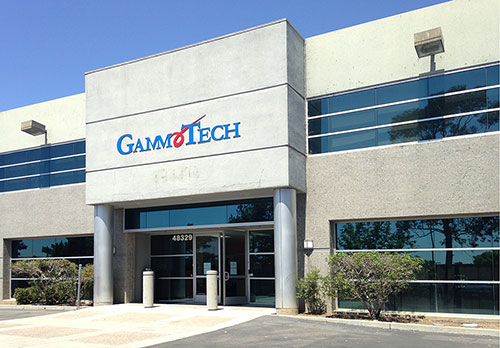
It's hard to believe that it's been 40 years since the Apple II rang in the era of personal computers, seen first just as expensive toys for nerds and hobbyists, but then, four years later, legitimized by the IBM PC.
The 1980s were the Wild West era of personal computers. PC trade shows drew huge crowds. Trade magazines had many hundreds of pages every issue. Everyone wanted in on the action.
Taiwan early on established itself as a major player in the OEM industry, OEM standing for Original Equipment Manufacturer, companies that actually make the products sold by another company under a different name. One such company in Taiwan was Twinhead International Corporation, established in 1984. Initially a domestic maker of PCs and peripherals, Twinhead soon branched into global markets, setting up subsidiaries in the US, Germany, France, and the UK, as well as distributors in dozens of other countries.
Twinhead USA, now known as GammaTech, was the first such international branch and became instrumental in distributing a succession of interesting, innovative Twinhead Slimnote, Superlap, Supernote and Efio! brand laptops.
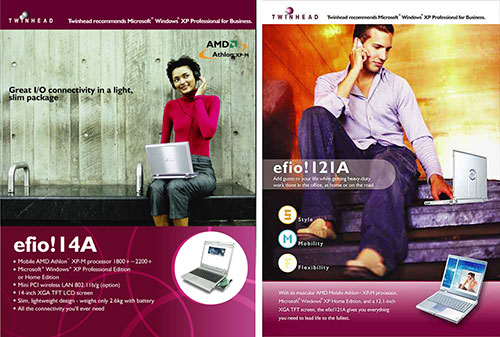
Times, however, changed. PCs became a commodity in a market increasingly dominated by a few large companies. Even IBM dropped out of the PC business, and other major players began concentrating on niche markets. Just as Panasonic launched the Toughbook and built that brand, Twinhead turned its focus to industrial and application-specific and mission-critical systems and launched the Durabook brand of rugged notebooks and tablets.
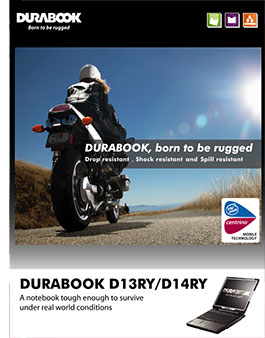 And when did the Durabook brand get started? It happened a little bit like with Panasonic whose rugged notebooks existed before the Toughbook name was introduced. Twinhead, likewise, launched their first military-grade rugged notebook, the N1400, around the turn of the millennium, but the Durabook brand itself began appearing in 2002.
And when did the Durabook brand get started? It happened a little bit like with Panasonic whose rugged notebooks existed before the Toughbook name was introduced. Twinhead, likewise, launched their first military-grade rugged notebook, the N1400, around the turn of the millennium, but the Durabook brand itself began appearing in 2002.
In our 2003 Comdex coverage, we reported that "Twinhead announced their latest series of semi-rugged notebooks that may prove to be tough competition for Panasonic." We had ample opportunity to examine Twinhead quality and ingenuity firsthand in products the company created for and with longtime partner and customer Itronix. An example was the Itronix GoBook Duo-Touch where our reaction was "Wow. They really nailed it this time." And the Itronix GoBook II — which started life at Twinhead's manufacturing plants before they were sent for final customer configuration at Itronix in Washington — became Pen Computing Magazine's Editor's Choice in the "high performance rugged notenbook."
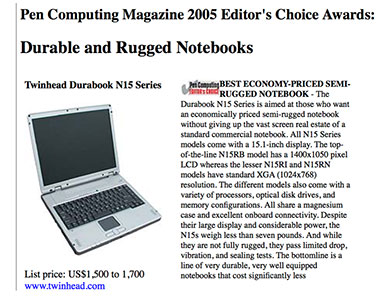 GammaTech displayed a show of strength again a couple of years later in the 2005 Pen Computing Magazine's Editor's Choice Awards where Durabooks battled Panasonic Toughbooks to a draw with two awards each.
GammaTech displayed a show of strength again a couple of years later in the 2005 Pen Computing Magazine's Editor's Choice Awards where Durabooks battled Panasonic Toughbooks to a draw with two awards each.
That same year, RuggedPCReview reviewed the Durabook N14RA. In the review we mentioned Twinhead's initial Durabook "Slim, mobile, ruggedized, and affordable" slogan, and that the N14RA certainly fit that bill. We liked not only the design and toughness of the N14RA laptop, but also praised Twinhead for a "masterful job selecting materials and textures". We also explained how the company had very productive relationships with major vertical market leaders such as Itronix, and thus has gained substantial expertise in the design and manufacturing of durable, ruggedized, and fully rugged mobile computing equipment.
Over the years, we have examined and reported on GammaTech Durabooks dozens of times. Around 2010-2012 we found Twinhead's N-Series of magnesium-bodied notebook computers "very solid and trust-inspiring." We were impressed with the Durabook U12C and R13S convertible notebooks that provided the same functionality as the market leaders, but at a significantly lower price.
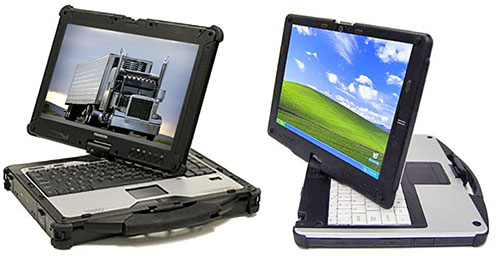
More recently, we applauded GammaTech making available the DurabookK R8300, an updated version of the Twinhead-sourced General Dynamics Itronix GD8200. This was a terrific fully-rugged laptop that appeared to vanish when General Dynamics closed down Itronix. But GammaTech brought it back better than ever.
We did detailed reviews of GammaTech's various rugged tablets and were particularly impressed with the still available Durabook R11: "to say that the GammaTech Durabook R11 is impressive would be an understatement." GammaTech then followed up with an updated R11 tablet in conjunction with a well-conceived keyboard that made for a very useful hybrid 2-in-1 ("A well conceived, well executed solution without any of the flimsiness and stability issues of most add-on keyboards"):
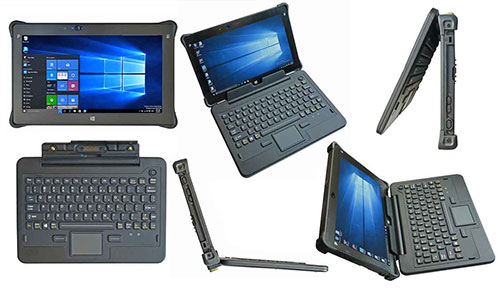
Likewise, we were impressed with the updated Durabook SA14 semi-rugged laptop and called it "a good deal for anyone who needs a high-performance, highly configurable notebook that is significantly tougher than standard consumer laptops and should hold up well in daily use".
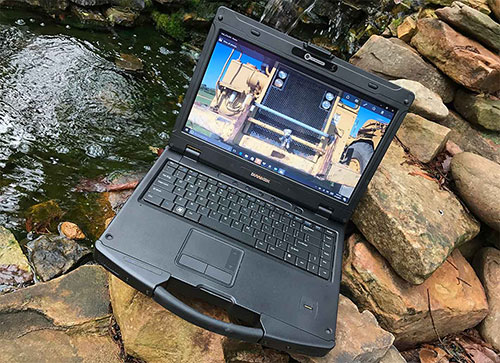
Overall, GammaTech could serve as a case study both of longevity based on exemplary quality and dedication, but also of the challenges of splitting business between OEM/ODM and one's own brands.
Given the company's experience in rugged markets and the remarkable quality and price points of its products, one would expect to find GammaTech among the rugged computing market leaders. But those spots are taken by Panasonic, with Getac and Dell battling for second place. The closing down of General Dynamics Itronix probably was a big blow for Twinhead. Another issue might have been product overlap as a result of OEM customers requesting similar but not identical models that could cause confusion when appearing under the Durabook name.
Now, celebrating its 30th birthday, GammaTech sports a trim, focused product lineup that includes the SA14 and S15AB semi-rugged laptops, the fully rugged R8300 laptop, the rugged R11 tablet that can also be used as a 2-in-1, the military-style 10-inch V10BB fixed-mount tablet/panel, and the multi-purpose 24-inch Durabook P24 workstation. Between the company's long established experience and track record, the Durabook brand equity, and a fine-tuned product roster that's not only technologically up-to-date but also attractively priced, the pieces are in place for GammaTech to set its sights on gaining marketshare.
So congratulations, GammaTech, on your 30th anniversary, and for contributing so much to making computers durable, tough and rugged enough to hold up out there on the job and in the field. And for keeping them affordable. Best of luck for the future. You have much going for yourselves.
Posted by conradb212 at 11:09 PM
















